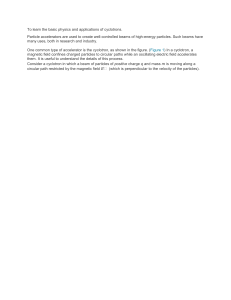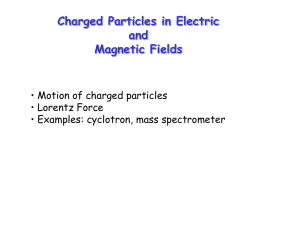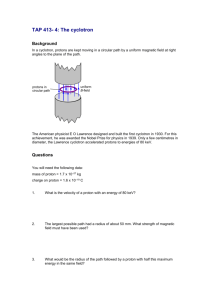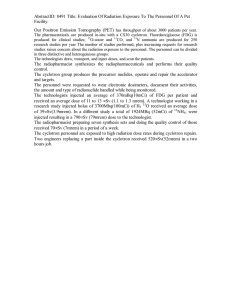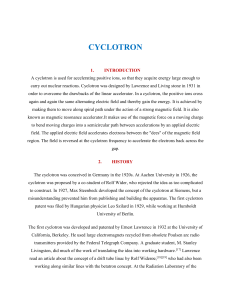Hall Effect
advertisement
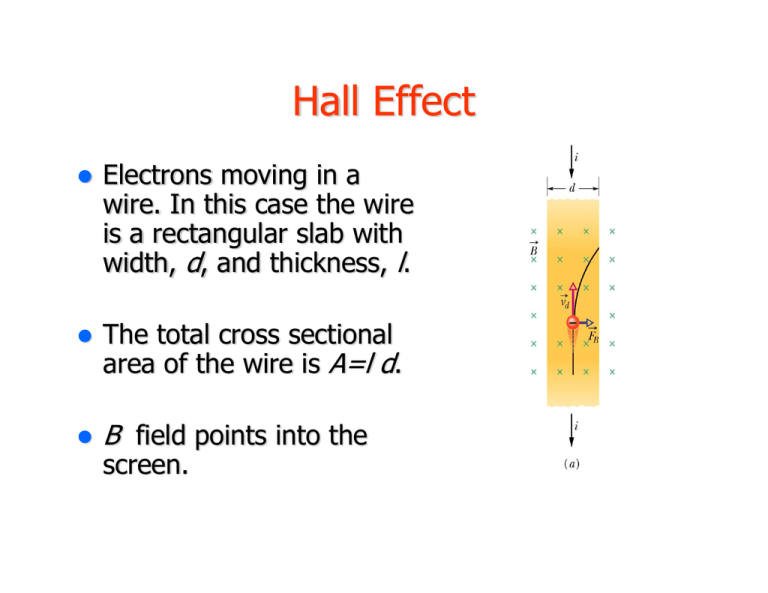
Hall Effect z Electrons moving in a wire. In this case the wire is a rectangular slab with width, d, and thickness, l. z The total cross sectional area of the wire is A=l d. z B field points into the screen. Hall Effect z z z Electrons moving in a wire (= current) can be deflected by a B field called the Hall effect Creates a Hall potential difference, V, across the wire Can measure the wire’s charge density when at equilibrium FE = FB Hall Effect z z z z Electrons have drift velocity, vd in direction opposite the current, i B field into page causes force, FB to right Electrons pile up on right hand side of strip Leaves + charges on left and produce an E field inside the strip pointing to right Hall Effect z E field on electron produces a FE to the left z Quickly have equilibrium where FE = FB E field gives a V across the strip z V = Ed z Left side is at a higher potential Hall Effect z Can measure the number of charge carriers per unit volume, n, at equilibrium FE = FB FE = qE r r FB =| qv × B | eE = evd B sin(90) E = vd B Hall Effect z Remember from Chpt. 27 that drift speed is J i = vd = ne neA iB E = vd B = neA iB n = EeA Hall Effect z Replacing E by V = Ed iB iBd n= = EeA VeA Hall Effect z If l is the thickness of the strip A l = d z Finally get iB n = Vle Magnetic Fields: Circular Motion z FB continually deflects path of charged particles z If v and B are ⊥, FB causes charged particles to move in a circular path z If B points towards you z z + particles move clockwise. – particles move counter clockwise. r r r FB = q v × B Magnetic Fields: Circular Motion z Derive radius of circular path for particle of charge, q, and mass, m, moving with velocity, v, which is ⊥ to B field r r FB =| qv × B |= qvB sin φ = qvB z z Newton’s second law for circular motion is Setting the forces equal and solving for r z Faster particles move in larger circles mv r= qB v2 F = ma = m r v2 qvB = m r Exercise A proton and an electron travel at same v (in the plane of the page). z z There is a B field into the page. A) Which particle follows the smaller circle? r ∝ m/q , |q_e |=|q_p |=e, and mp > me , so the electron has the smaller circle z z B) What direction does the electron move in? Clockwise Magnetic Fields: Circular Motion Period, T, is the time for one full revolution 2π r 2 π mv 2π m = = T = v v qB qB z z Frequency, f, is the number of revolutions per unit time 1 qB f = = T 2π m z z qB ω = 2π f = m Angular frequency, ω, is Only depend on q and m but not v Cyclotron z Cyclotron z z z z z Particles starts at the center. They circulate inside 2 hollow metal D shaped objects Alternate the electric sign of the Dees so V across gap alternates (the oscillator does this). Whole thing immersed in magnetic field B (green dots pointing out of page) ⊥ to v B approximately 1-10 T (tesla). Cyclotron z Cyclotron z z Proton starting in center will move toward negatively charged Dee Inside Dee E field = 0 (inside conductor) but B field causes proton to move in circle with radius which depends on v mv r= qB Cyclotron z Cyclotron z z When proton enters gap between Dees E field is flipped so proton is again attracted to negatively charged Dee Every time proton enters gap the polarity of the Dees is changed and the proton is given another kick (accelerated) Cyclotron z Cyclotron z Key is that the frequency, f, of the proton does not depend on v and must equal the fosc of the Dees f = f osc 1 qB f = = T 2π m qB = 2π mf osc
